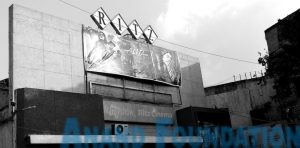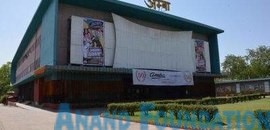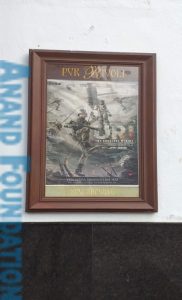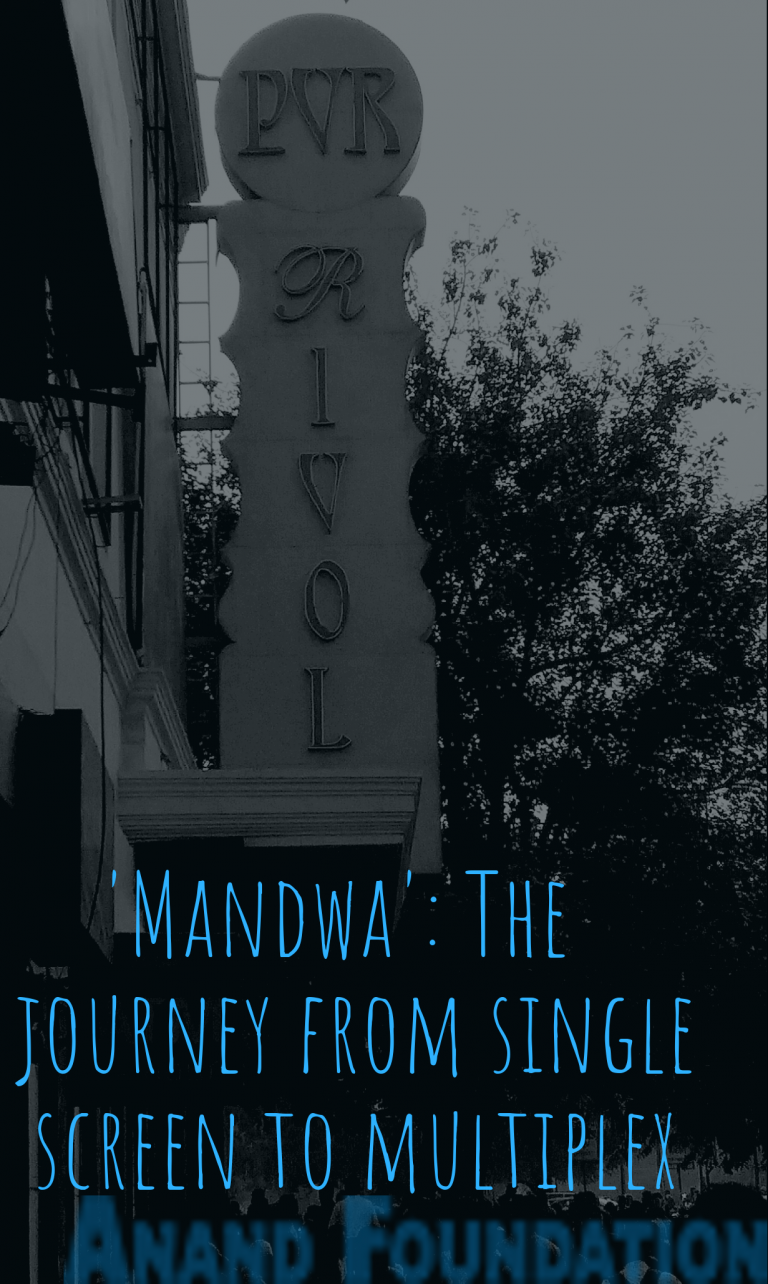“Mandwa” The journey from single screen to multiplex
INTRODUCTION

All over the world, we human beings are in deep love with the cinema. From being the source of entertainment, it has become a part of our life. It has become a way of expressing both for oneself as well as communities. Before the coming of ‘cinema’ in its present form, there were theatres, which performed plays in different parts of the country. Theatre (in its present form) came with the arrival of the Portuguese in India, in late 15th and early 16th century, who through theatre propagated Christianity. Gradually, these theatre companies developed in India and the most prominent among them was Parsi theatre group. It had its branches almost all over India.
In the early 20th century, theatres also began spreading across North India. The prominent language of theatre here, was the combination of Hindi and Urdu, which is Hindustani. Theatre was famous among all sections of society, irrespective of class. As we know it was a major source of entertainment in those days and was also affordable.

The content of the plays preferred, was different according to the social class. Back then, themes of theatre plays were either historical or mythological, which was also true in the early days of the cinema. The main patrons of these theatres were people, who were called ‘Chawaniwale’, these were people who preferred to buy tickets at the lowest rates (chawani). In Delhi, theatre was also called ‘Mandwa’, which stands for a large space with a rooftop. For instance, ‘Excleisor’ cinema in Delhi called ‘Seerki walo ka mandwa’, because the area around the hall was dominated by Bamboo workers. Even, the famous ‘Jagat’ cinema hall in the Chandni Chowk was called the ‘Macchliwalo ka Mandwa’, due to the presence of fish market in that area. This market is still there even today and the hall is also famous by this name among local population.
In Delhi, especially in old Delhi, cinema halls were not built for the purpose of cinema initially, they were centre of political activities as well, such as in pre-partition era, two conferences of Muslim league held in the famous ‘Moti Talkies’. It is with the coming of Bioscope (it is a movie and also referred as travelling movie theatre. It tells a story with the use of graphics or non-mobile pictures set in slides) and silent movies, which ultimately led to the decline of theatre as a major source of entertainment and paved way for the cinema halls.
The era of silent movies also declined with the coming first talkie movie, ‘Alam Ara’ in 1931. As the era of silent movies paved way for black and white movies with songs and dialogues, the theatre halls began to show movies and as result they were called ‘talkies’ and most of them also added it as a suffix to their name, such as ‘Moti Talkies’, ‘Jagat Talkies’ etc. The experience of cinema watching of different places cannot be generalized, especially seeing the diversity of India. The same is applicable also on Delhi.
The cinema or Single Screen talkies emerged in Delhi at a time, when the city was going through a major transformation period. With attaining Independence in 1947, India is entering into a new period of hope and ambitions, as a sovereign and independent country. And being the capital of this newly sovereign country, the experience of Delhi would definitely be different from rest of India. This was also the time when Delhi was coming out of its, British and Mughal legacy. Thus, it could not be said that the early cinematic history of Delhi was a straight affair. It could not be said that whatever came in the form of movies, was simply consumed by the people of Delhi.
The social scenario of Delhi was still very much conservative regarding several changes. This was true especially in the case of elite and high class and caste families across all communities. The nature of viewing cinema changed with the changing social, political and economic scenario in the country. With the establishment of Single Screen halls first in old Delhi, the people of the city got their major source of entertainment outside the household.

Just like today, going for a movie was a special occasion. In those times, the cinema hall one was going to watch a movie was also the symbol of social status. In the cinematic history of Delhi, the era of Single Screen halls is a period of nostalgia and attachment to a particular area and building.
As Ziya Us Salam, the editor in chief of ‘Hindu’ newspaper shown in his book ‘Delhi 4 shows: Talkies of Yesteryear’ that how the demographical profile of the city was/is led the cinema. The present paper focuses on the journey of cinema in Delhi through its Single Screen halls from post partition era to economic reforms of 1991 and how the coming of first, VCR and video and then later of the color TV and the emergence of Multiplexes led to the decline of Single Screen halls of Delhi.
THE WALLED CITY

The Walled City, or better known as Old Delhi, was where the cinema halls in Delhi first came up. This had happened around the 1920’s and then they emerged in Connaught Place. This was the time when the old city was ‘The’ Delhi or power of centre, and the areas of C.P. and south Delhi had not dominated yet. Just like any other part of Delhi, the demographic profile of the walled city, in a way decided the direction of movie business here. The old Delhi in post partition era, was occupied by the elite class of the Indian society.
Even the elite people who were coming from Pakistan in post partition period partially preferred to live in Old Delhi. It is one of the reason that the experience of this area was very different from other parts of Delhi. There are several features regarding cinema halls, which were special to old city only. Just like any other hall, talkies here also had specific patrons, such as Jagat Cinema was mostly preferred by Muslim gentry and Moti talkies preferred by Hindus, though there was no hard and fast rule regarding this.
Not surprising, there were social taboos regarding watching movies in cinema halls in initially days of the emergence of single screen. The movies were not considered morally high. The women of so called ‘sharif khandan’ or old Nawabi families were not allowed to watch movies. It is Because of these social restrictions that the idea of private boxes came up in Old Delhi. These boxes were either preferred by families, women or couples who wanted to spend some private time. If we see, these boxes were also symbol of class segregation as the tickets for these private spaces would definitely be much more than other general seats. Thus, it would not have been possible for everyone to pay for these spaces. Hence, these boxes were a symbol of class status. Also it would not be surprising to know that the restrictions regarding watching cinema were much more on women than men. However, just like today it was not possible to keep oneself away from the magic of watching something larger than life through cinema. Thus despite having restrictions, women especially muslim women took transport from the only ‘women park’ near Netaji Subhash marg, which is called ‘Purdah park’ to watch movies in Kashmere Gate Cinema halls.

The demographic profile of a particular area mattered a lot in deciding what kind of movies any particular cinema hall would play. The famous ‘Jagat Cinema hall’, while choosing a movie, took care of the feelings of the people living in that area, as it was situated near Jama Masjid. The same was true also about Majestic, which was situated near Gurdwara Sisganj and Sahib Sunheri Masjid. They have also tried to avoid cinema and faith.
That means they had to ensure that the content shown in the hall is free from profanity of any kind. In the early 21st century, the license of the Jagat cinema got cancelled by the government after the allegation that it showed intimate content. The restriction regarding what could be shown and what could not in halls, dominated during this time. There were certain elite families who did not allow their children or other family members to watch movies especially Hollywood movies. They were of the view that the content shown in English movies were against their cultural values. But this stand of some families cannot be generalized, because there were several elite families who encouraged their children to watch English movies, as it was also related to social status. One thing which I find unique to Old Delhi and its surrounding areas, is that other than newspaper columns, another way of promoting movies was via hoardings in Hindi, Urdu and English; announcement on rickshaws and music band performance in the streets of Old Delhi etc. During my research, when I asked people about this promotion stunt, they were unaware about it. What makes the Single Screen cinema halls, especially in old Delhi and C.P., different from other Single Screens and even Multiplexes was the grand and royal architecture of the former. In Old Delhi, Single Screens like Delite were famous for their larger than life architecture. The same can be said true about halls of C.P. like Regal, Rivoli, Odeon etc. One major reason for their larger than life architecture was that many of these halls were either built by British government or took care of the taste of elite audience which included both English and Indians. Also if you have enough money to invest then it was normal to build architecture of Mughal and British standards. The decline in the popularity of Single Screen halls here began much earlier even before the coming of TV, Video or Multiplexes, the main reason for this was the departure of the elite population of Old Delhi to other parts of the city. This led to the settlement of migrate labour force from other states of the North India, for whom entertainment and flashy movies mattered more than the content and artistic importance of the cinema. Subsequently, these famous cinema halls, which were once respected for their choices of movies and grand architecture, reduced to watching c- grade movies.
THE CONNAUGHT PLACE
In the post- independence this and other newly built parts of Delhi or ‘New Delhi’ also called Lutyens’ Delhi were the symbol of modernization and advancement. The Mughal and indigenous architecture lost its importance and was seen as something that belonged to past and decay. At this place emerged some of the best Single Screen halls of Delhi. The Single Screens here mostly preferred by producers and distributors of the movies to screen latest movies. That is the reason any new movie would first came here and then only in the other parts of Delhi. Here, the architectural style of buildings was also predominantly European.
The oldest Single Screen in C.P. is Regal that came in 1932, the same time when Single Screen halls emerged in the Walled City. In its initial days, it was a theatre and staged various English plays for British diplomats and Indian royals. These were the halls, where Bollywood stars came up for the promotion and screening of their movies.
Another Single Screen hall was Rivoli, the only hall which played English movies. It was the first choice for the elite people of the city. It was only after the screening of the movie Aaradhna starring Rajesh Khanna, that it began playing Hindi movies as well.

Then there was the famous and one of the oldest halls, Plaza, designed by British architect Robert Tor Russell. It was the first hall in Delhi, which served cold coffee to its guest. In the initial years, here also the focus was on English movies but gradually the increasing demand for Hindi movies, led to focus on latter’s screening. Due to the decline of Single Screens in Delhi, this hall merged into the PVR chain. Another hall of 1960’s was Sheila, which narrowly missed being Asia’s first 70mm screen, due to the mistake of the electricity department of Delhi. This hall was famous for playing English movies. Before the coming of other halls like Chankya, Priya, Sheila spoke the language of the haves.
Patriotic gesture was also part of the history of these halls. During the 1962 war, it handed over its generators for the larger cause to Indian government. Another famous incident is that during emergency, the Indira Gandhi government closed down the hall on some useless issue. In protest of these, Sheila decided to close down and even when government allowed to reopen it, Sheila choose to reopen only after 2 days of the permission, arguing that “dishonesty should not be encouraged”.
As even stated above the story of Imperial hall, also shows that the social demographic profile of a particular area mattered most in deciding both the fate of hall as well as movies. It is situated near the railway. In the pre partition days, it was a hall which staged various English plays and had the reputation of being a decent place. Various high profile people visited here. But during the partition, coming of large number of migrants in this part, led to decline in the reputation of the hall.
Now the crowd did not want any highly classical act of movie, they just want to see entertainment, which eventually led to the shift of the hall to c- grade movies. And the multiplex replaced single screen here as well.
Other Parts of Delhi
If one see carefully, the development or the expansion of city in other parts led to significant changes in the nature of halls. The inflow of population first due to partition and latter due to the needs of livelihood, completely transformed the cinema of the city.
When theatre or last Single Screen started in the city, it was Old Delhi and then Connaught place, the predominant choice of cinemagoers.

It was now that the areas of South Delhi, West Delhi and other which began to be called the most ‘posh’ areas of the city. For example, the coming of Chankya hall in South Delhi and development of the area around, led to preference of a different kind of cinema from earlier. First, the emergence of Single Screen halls, which preferred English and family movies and later the Emergence of Multiplexes, created a class segregation in the city. Now, no one wanted to go watch movies in Old Delhi, because what would the crowd be like mattered a lot to the elite people and what they wanted was a more ‘decent’ crowd.

The area is a huge factor either in the decline or emergence of halls in Delhi. For example, there were several hall which were located in the places such asthe areas of West Delhi where Jatt population dominated, one could see movies of Sunny Deol and Dharmendra most popular here

The major reason of the decline of Single Screen halls was the coming of TV and VCR in 1980’s and 90’s. Now people get all the entertainment without spending on the movie ticket, at home. This led to the decline of Single Screens. When Single Screen did not have funds, they either shifted to c-grade films, to cover their expenses or closed down their shutters. The coming of multiplex also led to the decline, but it was later and cannot be said to be the major reason.
CONCLUSION
“The tunes have changed, the notes remain the same,” said Ziya Us Salam in his book ‘Delhi 4 Shows’ is the best line to describe the era of Single Screen halls in Delhi. The craze for cinema is increasing day by day. Today, Dilliwallas have shifted from the Single Screen to multiplex halls, but the nostalagia of Single Screen is still there in the older generation. Sohail Hashmi and many other people, I interviewed, pointed out that watching movies is special even today but the only difference is that at that time we used to plan days before and would have to wait for tickets since there was no Bookmyshow to ease the process then. Nowadays, when people go to watch movies, taking selfies is also part of watching movie for them, which creates disturbance for other people, but this was not the case, during earlier times.
I am from the generation of Multiplexes, I always wonder is it possible to have an attachment with today’s halls, which people had with Single Screens? Frankly, I don’t have any attachment with any hall, but Old Single Screen halls attract me more due to their grand architecture.
On the other hand, Multiplexes are very uniform in their appearance. In general, people have an attachment with buildings or places which have something unique. Also, unlike earlier times, today people have a lot of options in terms of cinema halls. Even as Sohail Hashmi pointed out, “the old films during Single Screen had a different kind of reach to its audience, which Multiplexes don’t have. Today, a film goes off from halls in two weeks, earlier movies went on for years in the halls. For ex. Mughal-e-Azam was housefull for 2 years in Golcha cinema hall.”
In this paper, the focus was also on the demographical profile of the city. How the social scenario of a particular area decided whether a particular movie would run in that place or not. In the view of uniformity during the time Multiplexes, it is difficult to think of such social dominance. However, as Professor Vibhas Verma from Deshbandhu College pointed out that even today the demographical profile of an area mattered. He gave example of regional movies. For example, movies in Punjabi language are screened at the limited Multiplexes halls of Delhi, where that kind of audience is there who would prefer to watch Punjabi movie. The same thing was also pointed out by Sohail Hashmi, who is of the view that to an extent it still matter. He gave example of Chankya cinema hall and halls in the elite areas of Delhi, where there is possibility that the movies of Salman Khan would not find mad fan following.
The coming of digital platforms like Netflix and Amazon Prime made to think, what is the future of Multiplexes? Will people still prefer to go and watch movies in the halls? However, the people I talked during my research has one thing common to say that the larger than life experience of watching movie in a hall, without any disturbance in the dark could not possibly be replaced by either TV or these emerging digital media platforms. Going in the cinema hall for a 3 hour movie is still an outing. The journey of Single Screen in Delhi has today culminated to the screening of either c-grade movies or complete shutdown. However, the journey of cinema in the city is taking new turns with each decade and defining the city in new ways.
REFERENCES
- Delhi 4 shows: Talkies of Yesteryear by Ziya Us Salam
- India’s experience with Multiplex by Aparna Basu
- From the ruins of Chanakya: Exhibition History and urban Memory by Ipsita Sahu

